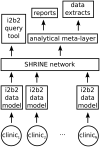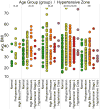Using i2b2 to Bootstrap Rural Health Analytics and Learning Networks
- PMID: 28261006
- PMCID: PMC5324727
- DOI: 10.1109/EMBC.2016.7591246
Using i2b2 to Bootstrap Rural Health Analytics and Learning Networks
Abstract
We demonstrate that the open-source i2b2 (Informatics for Integrating Biology and the Bedside) data model can be used to bootstrap rural health analytics and learning networks. These networks promote communication and research initiatives by providing the infrastructure necessary for sharing data and insights across a group of healthcare and research partners. Data integration remains a crucial challenge in connecting rural healthcare sites with a common data sharing and learning network due to the lack of interoperability and standards within electronic health records. The i2b2 data model acts as a point of convergence for disparate data from multiple healthcare sites. A consistent and natural data model for healthcare data is essential for overcoming integration issues, but challenges such as those caused by weak data standardization must still be addressed. We describe our experience in the context of building the West Virginia/Kentucky Health Analytics and Learning Network, a collaborative, multi-state effort connecting rural healthcare sites.
Figures





Similar articles
-
Data interchange using i2b2.J Am Med Inform Assoc. 2016 Sep;23(5):909-15. doi: 10.1093/jamia/ocv188. Epub 2016 Feb 5. J Am Med Inform Assoc. 2016. PMID: 26911824 Free PMC article.
-
Distributed data networks: a blueprint for Big Data sharing and healthcare analytics.Ann N Y Acad Sci. 2017 Jan;1387(1):105-111. doi: 10.1111/nyas.13287. Epub 2016 Nov 18. Ann N Y Acad Sci. 2017. PMID: 27862002 Review.
-
At the crossroads: NRTRC white paper examines trends driving the convergence of telehealth, EHRs and HIE.World Hosp Health Serv. 2010;46(4):17-23. World Hosp Health Serv. 2010. PMID: 21391447
-
Big Data Analytics in Medicine and Healthcare.J Integr Bioinform. 2018 May 10;15(3):20170030. doi: 10.1515/jib-2017-0030. J Integr Bioinform. 2018. PMID: 29746254 Free PMC article.
-
Big Data Analytics for Genomic Medicine.Int J Mol Sci. 2017 Feb 15;18(2):412. doi: 10.3390/ijms18020412. Int J Mol Sci. 2017. PMID: 28212287 Free PMC article. Review.
Cited by
-
Using Closure Tables to Enable Cross-Querying of Ontologies in Database-Driven Applications.IEEE EMBS Int Conf Biomed Health Inform. 2017 Feb;2017:493-496. doi: 10.1109/BHI.2017.7897313. Epub 2017 Apr 13. IEEE EMBS Int Conf Biomed Health Inform. 2017. PMID: 28725879 Free PMC article.
References
-
- State public health statistics. [Accessed Mar. 8, 2016]; [Online]. Available: http://www.americashealthrankings.org/states.
-
- The institute for healthcare improvement: the ihi triple aim. [Accessed Mar. 8, 2016]; [Online]. Available: http://www.ihi.org/engage/initiatives/tripleaim/pages/default.aspx.
-
- Harris DR, Harper TJ, Henderson DW, Henry KW, Talbert JC. Proceedings of the IEEE International Conference on Biomedical and Health Informatics. IEEE; 2016. Informatics-based challenges of building collaborative healthcare research and analysis networks from rural community health centers; pp. 513–516. - PMC - PubMed
-
- Bahensky JA, Jaana M, Ward MM. Health care information technology in rural america: electronic medical record adoption status in meeting the national agenda. The Journal of Rural Health. 2008;24(2):101–105. - PubMed
MeSH terms
Grants and funding
LinkOut - more resources
Full Text Sources
Other Literature Sources
Medical
